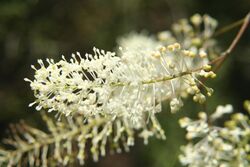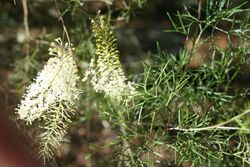Biology:Grevillea leptopoda
| Grevillea leptopoda | |
|---|---|

| |
| Scientific classification | |
| Kingdom: | Plantae |
| Clade: | Tracheophytes |
| Clade: | Angiosperms |
| Clade: | Eudicots |
| Order: | Proteales |
| Family: | Proteaceae |
| Genus: | Grevillea |
| Species: | G. leptopoda
|
| Binomial name | |
| Grevillea leptopoda McGill.[1]
| |
Grevillea leptopoda is a species of flowering plant in the family Proteaceae and is endemic to the south-west of Western Australia. It is a spreading to erect shrub with divided leaves, the lobes further divided, the end lobes linear, and clusters of white to cream-coloured flowers.
Description
Grevillea leptopoda is a spreading to erect shrub that typically grows to a height of 0.6–1.5 m (2 ft 0 in–4 ft 11 in), its branchlets silky-hairy. The leaves are 40–80 mm (1.6–3.1 in) long and divided with three to five lobes, the side lobes usually further divided three times, the end lobes linear or tapered, 5–45 mm (0.20–1.77 in) long and 0.6–1.2 mm (0.024–0.047 in) wide. The flowers are arranged on the ends of branches and in leaf axils in sometimes branched clusters on a rachis 40–60 mm (1.6–2.4 in) long. The flowers are white to cream-coloured, the pistil 7.5–9 mm (0.30–0.35 in) long. Flowering occurs from August to November and the fruit is a oblong follicle 9–10.5 mm (0.35–0.41 in) long.[2][3]
This grevillea is similar to G. teretifolia which has a rachis 10–30 mm (0.39–1.18 in) long and pistil 10–17 mm (0.39–0.67 in) long.[2]
Taxonomy
Grevillea leptopoda was first formally described in 1986 by Donald McGillivray in his New Names in Grevillea (Proteaceae) from specimens collected near the Brand Highway north of Carnamah in 1953.[4] The specific epithet (leptopoda) means "slender foot", referring to the thin flower pedicels.[5]
Distribution and habitat
This grevillea is found from Kalbarri south to Moora, growing among medium to low trees in tall shrubland, mallee or heathland[2] It will grow in rocky, stony or sandy lateritic soils.[3]
Conservation status
Grevillea leptopoda is listed as "Priority Three" by the Government of Western Australia Department of Biodiversity, Conservation and Attractions,[3] meaning that it is poorly known and known from only a few locations but is not under imminent threat.[6]
Use in horticulture
This species has heavily scented flowers and is used in domestic gardens in warmer areas.[7]
See also
References
| Wikimedia Commons has media related to Grevillea leptopoda. |
- ↑ "Grevillea leptopoda". Australian Plant Census. https://biodiversity.org.au/nsl/services/apc-format/display/90659.
- ↑ 2.0 2.1 2.2 "Grevillea leptopoda". Australian Biological Resources Study, Department of Agriculture, Water and the Environment: Canberra. https://profiles.ala.org.au/opus/foa/profile/Grevillea%20leptopoda.
- ↑ 3.0 3.1 3.2 "Grevillea leptopoda". FloraBase. Western Australian Government Department of Parks and Wildlife. https://florabase.dpaw.wa.gov.au/browse/profile/2030.
- ↑ "Grevillea leptopoda". APNI. https://id.biodiversity.org.au/instance/apni/512364.
- ↑ Sharr, Francis Aubi; George, Alex (2019). Western Australian Plant Names and Their Meanings (3rd ed.). Kardinya, WA: Four Gables Press. pp. 238–239. ISBN 9780958034180.
- ↑ "Conservation codes for Western Australian Flora and Fauna". Government of Western Australia Department of Parks and Wildlife. https://www.dpaw.wa.gov.au/images/documents/plants-animals/threatened-species/Listings/Conservation%20code%20definitions.pdf. Retrieved 16 June 2022.
- ↑ "Fact Sheet: A Native Cottage Garden". Australian Broadcasting Corporation. 1 October 2011. http://www.abc.net.au/gardening/stories/s3326696.htm.
Wikidata ☰ Q2710302 entry
 |



